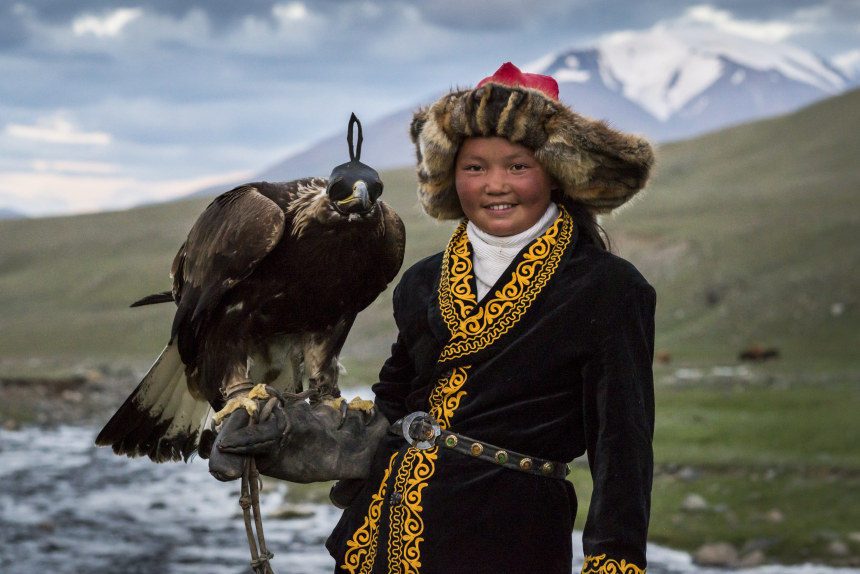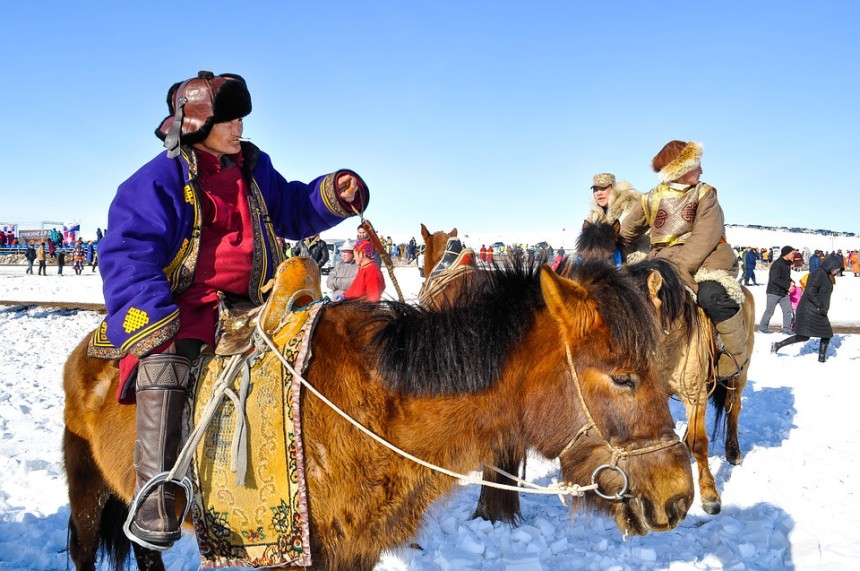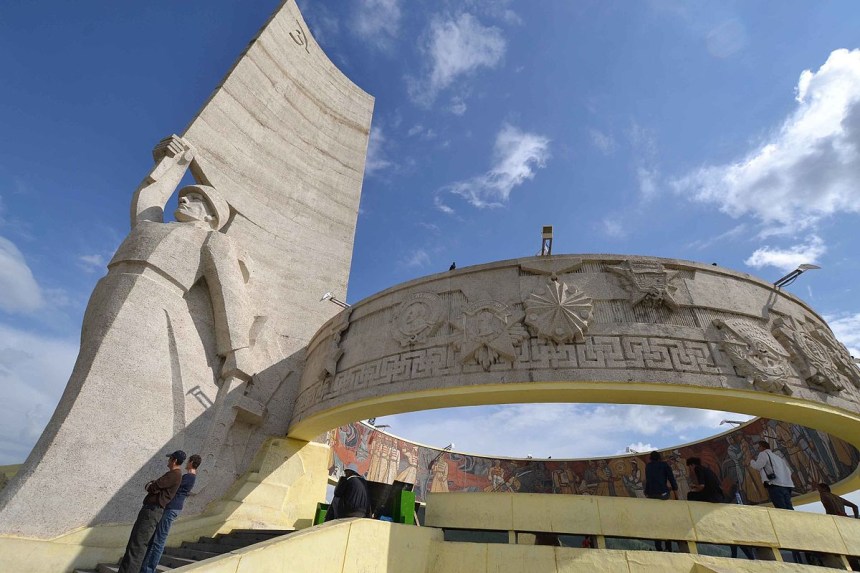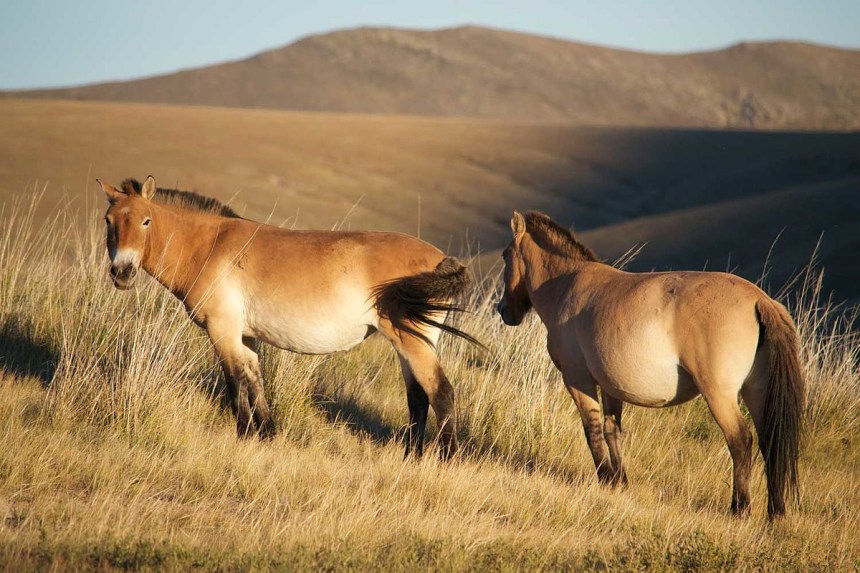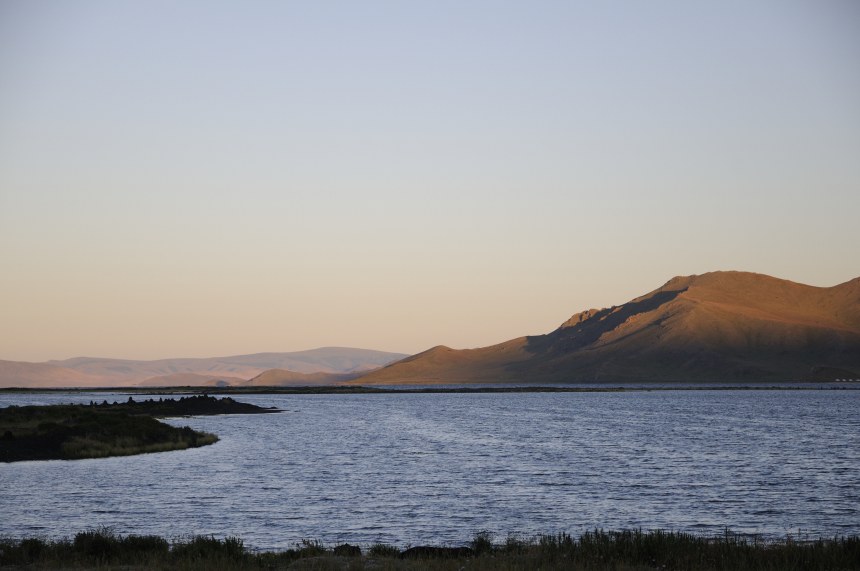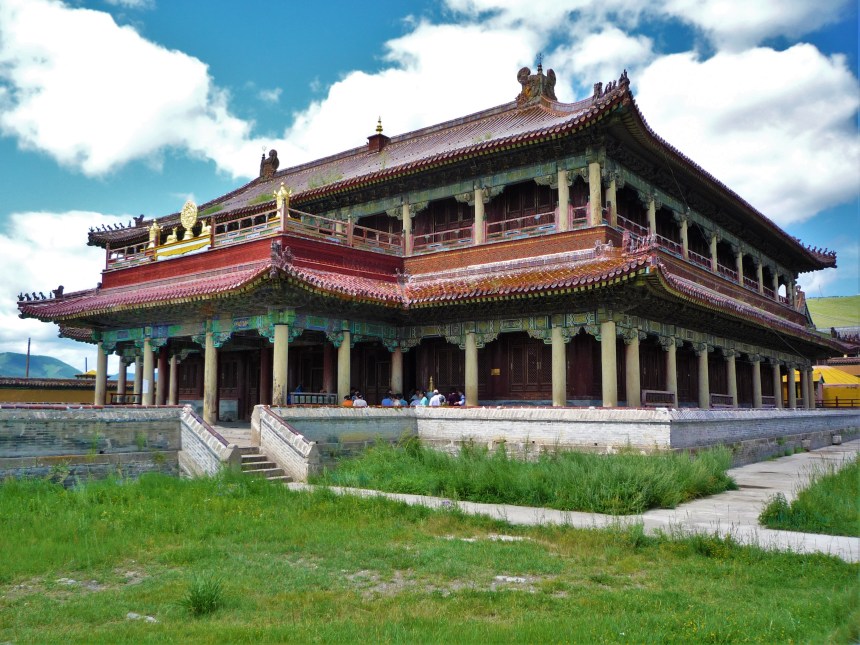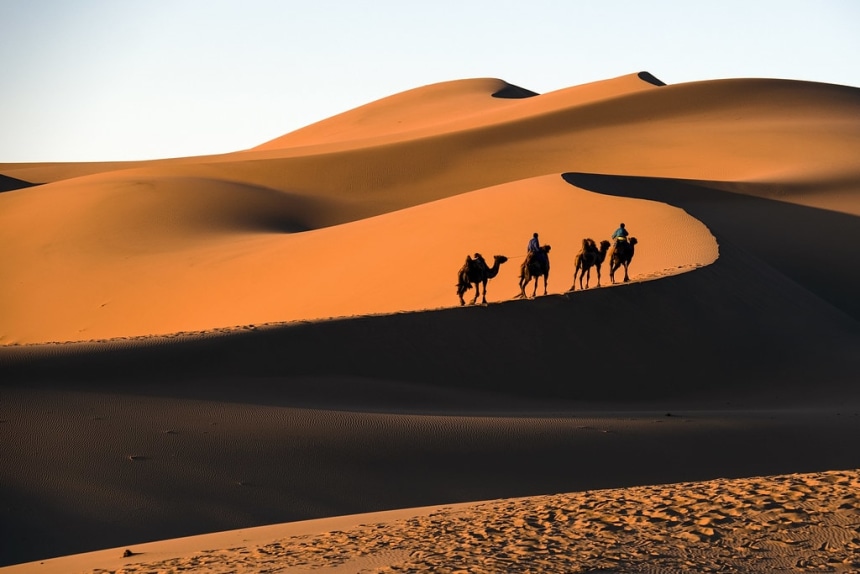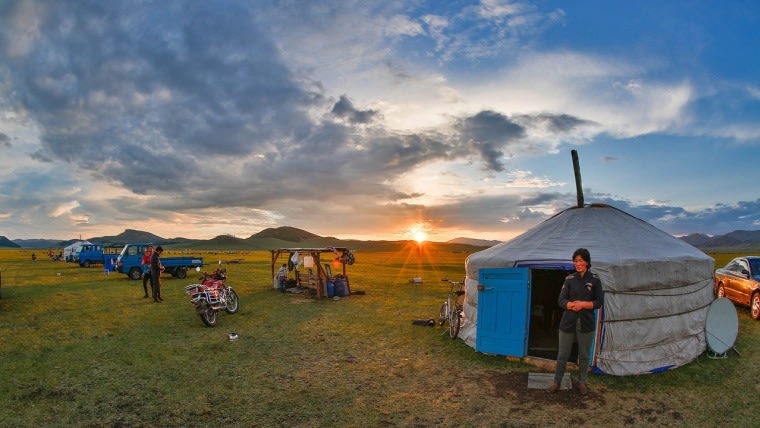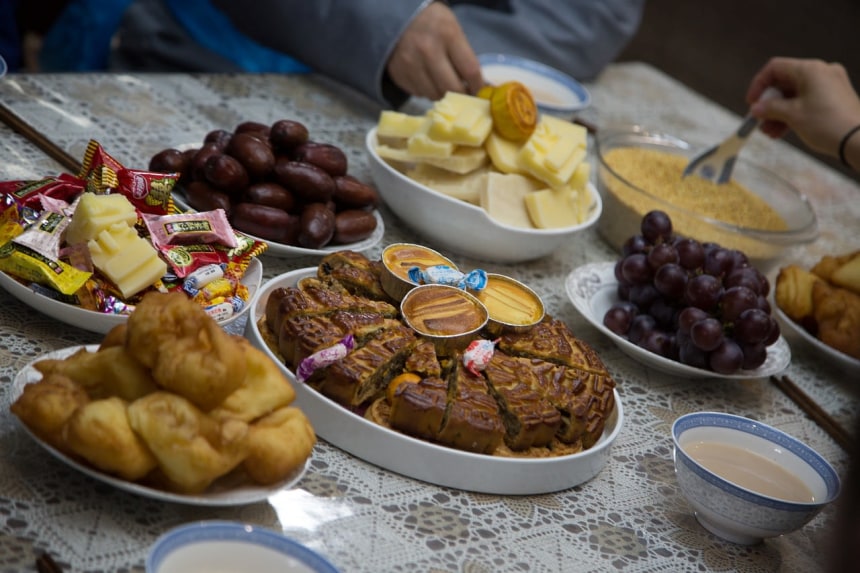| 8 mins read
Ross Cameron
Mongolia is like nowhere else on earth. A disorientating and thrilling blend of ancient nomadic traditions, Buddhist religious practices and Soviet modern history, this landlocked Central Asian country, sandwiched between Russia and China, is the place to go for once in a lifetime experiences. Whether you are looking to go horseback riding with eagle hunters in the rolling steppe, wonder at panoramic views from a mountain top communist monument or hunt for dinosaur fossils, this travel guide to the unique experiences you can only have in Mongolia has you covered.
Visit the Ölgii Eagle Festival
Catapulted to fame by Otto Bell’s beguiling documentary film The Eagle Huntress, Mongolia’s Kazakh minority’s rich tradition of hunting with eagles will leave any visitor to the country astounded. The best place to see this spectacle (which is not just for show, as eagle hunting is a well-respected profession) is during the annual Ölgii Eagle Festival, which takes place in Bayan Ölgii in Mongolia’s far west. Every October around 500 eagle hunters gathers to show off their skills in front of vast crowds of Kazakhs (and now a growing number of tourists). Alongside hunting with eagles, there are also camel races and traditional horse games. All in all, this is one of Mongolia’s most unforgettable experiences.
Go horse riding in the world’s oldest nature reserve
Established in 1778, Bogdkhan Uul is said to be the world’s oldest nature reserve. Once guarded by Buddhist lamas who would imprison and sometimes execute suspected poachers, the reserve is today a far more sedate affair with the chance to take part in traditional Mongolian horse-riding activities. Tour companies in nearby Ulaanbaatar can organize everything from horseback day trips around the park to two-week excursions deep into the park’s wilderness. Their expert guides are able to instruct visitors of all levels how to ride horses in a traditional Mongolian fashion and they also welcome volunteers who are looking to help muck out the horse stables.
Get to grips with Mongolia’s unusual World War Two history at the Zaisan Memorial
It may be hard to imagine Mongolian troops fighting their way into Berlin in 1945 but that is exactly what happened. Subsumed into the Red Army during World War Two, the Mongolian army assisted Soviet forces in their fight against Nazism in Europe. To get a better understanding of this unique moment in history, hike up to the Zaisan Memorial, which sits on a hilltop overlooking Ulaanbaatar. This circular mosaicked monument illustrates in Soviet Realist style, the friendship between the Soviet Union and Mongolia. While much of this was little more than propaganda designed to reinforce communist influence in the country, the monument and accompanying museum do showcase the experiences of Mongols who fought against fascism.
See the revival of takhi wild horses first-hand
By the 1970s Mongolia’s population of takhi horses, which are native to the steppe of southern Siberia and Mongolia, had dwindled to next to nothing. Faced with these iconic animals becoming extinct, the Mongolian government implemented various breeding programmes, the success of which is best seen at Khustain Nuruu National Park. There are now upwards of 2000 takhi in the park and, unlike most ‘wild’ horses, the takhi is not a feral domesticated horse. In fact, these horses have never been used by humans and simply spend their days, as they have done for the last millennia, grazing the steppe. When in the park watch out for other iconic Mongolian wildlife, including Eurasian lynx and steppe gazelle.
Explore Mongolia’s shamanistic culture at Terkhiin Tsagaan Lake
From a distance, it is hard to tell what is going on, on the shoreline of Terkhiin Tsagaan Lake, which sits more than a mile above sea level. The shore is dominated by rocky columns that look like one of nature’s most bizarre rock formations – that is until you get closer and realise, they are more like manmade cairns. These strange features of the landscape are called ovoos and are shamanistic monuments designed to be circled by travellers three times so as to ensure a safe journey. While they can be found across the country, those at Terkhiin Tsagaan Lake are some of the most unusual for their sheer density, height (some can reach 3 metres tall) and the fact they are made from black lava stones.
Learn about Mongolia’s rich Buddhist traditions at Amarbayasgalant Khiid
Built by the Qing emperor Yongzheng in the mid-18th century, the Buddhist temple of Amarbayasgalant Khiid is one of Mongolia’s most astounding cultural sites. Bedecked in colourful prayer flags that flutter in the steppe breeze and peppered with ornate pagodas that are slowly being taken over by nature, the temple is also one of the country’s most atmospheric locations. Indeed, the temple, which is now inhabited by only a handful of monks, is a far cry from its early 20th-century peak when it housed 2000 students.
Highlights of the temple include the mummified body of the Mongolian sculpture Zanabazar, who is famed for his works of Buddhist art, and the Manchurian inspired decorative style, which echoes that of the Qing Dynasty’s homeland. Indeed, pay special attention to the temple’s colour scheme, as it is designed to represent the Qing imperial colours.
Dig for dinosaur fossils in the Flaming Hills
While you cannot exactly apply the rule of finders’ keepers to anything you discover in the ground in Mongolia’s Flaming Hills, the area is quite literally littered with fossils that you can marvel at. Located deep in the Gobi Desert, which is baking in summer and one of the coldest places on earth during winter, the hills are known for their red coloured soil, hence their name. Notable finds in the area include dinosaur eggs, a velociraptor and a protoceratops. Otherwise, you may see the odd fossilised leave imprinted in the rocks or that of small ancient animals – it really is a walk through earth’s history. The hills themselves are located near Dalanzagad but to find them, it is best to go with a Flaming Hills guide who can show you the way.
Spend a night in a traditional ger
You can stay in a hotel or apartment anywhere in the world but only in Mongolia do visitors get the unique opportunity to stay in a traditional ger – a form of nomadic housing similar to a yurt usually found in some of the most isolated locations in the steppe. Peppered across Mongolia are ger camps that cater primarily for visitors to the country. Kitted out with traditional Mongolian furnishings and built around roaring wood fires, these gears are one of the country’s most atmospheric forms of accommodation and stay warm even in the country’s frigid winter months.
Get a taste of traditional Mongolian cuisine
Mongolia may not seem like a foodie destination but in fact, it offers visitors one of the world’s most unique cuisines that have been shaped by the country’s harsh climate and nomadic traditions. As such, vegetables are few and far between in Mongolian cuisine and meats like mutton dominate. A favourite dish for visitors is buuz, which is the country’s national dish. These dumplings are a ubiquitous street food item across the country and are usually stuffed with mutton or cheese and boiled. However, if it is eaten in a restaurant they can also be served in a bone broth. Beyond this, barbeque dishes are popular with khorkhog comprising a whole animal roasted over open flames before being mixed with vegetables. The Mongolians also make some of the world’s most unusual sweet dishes, including qurut, a dried and fermented cheese biscuit that is served with fatty yak butter, and orom, a form of clotted cream derived from yak milk that is usually served with bread.
“Over the past decade, Ross Cameron has travelled extensively across Europe, Southeast Asia, North America, North Africa, and the post-Soviet space. As someone who has areal passion for these regions of the globe, he is able to offer an expert opinion that highlights the best off the beaten track destinations.”
Image details and licenses: Eagle hunter: https://flic.kr/p/o8nPAk (David Beckensale, CC BY-ND 2.0), Zaisan Memorial https://commons.wikimedia.org/wiki/File:Zaisan_Hill.jpg (Ulaanbaatour, CC BY 4.0) , Takhi https://commons.wikimedia.org/wiki/File:Takhi.jpg (Ulaanbaatour, CC BY SA 4.0), Terkhiin Tsagaan Lake https://commons.wikimedia.org/wiki/File:Terkhiin_Tsagaan_Nuur8.JPG (Arabsalam, CC BY SA 4.0), Amarbayasgalant Khiid https://commons.wikimedia.org/wiki/File:Amarbayasgalant_monastery_temple_01.JPG (Bogomolov), Terkhiin Tsagaan Lake: https://flic.kr/p/6xrxqv (Johannes Lundberg, CC BY-NC 2.0)


